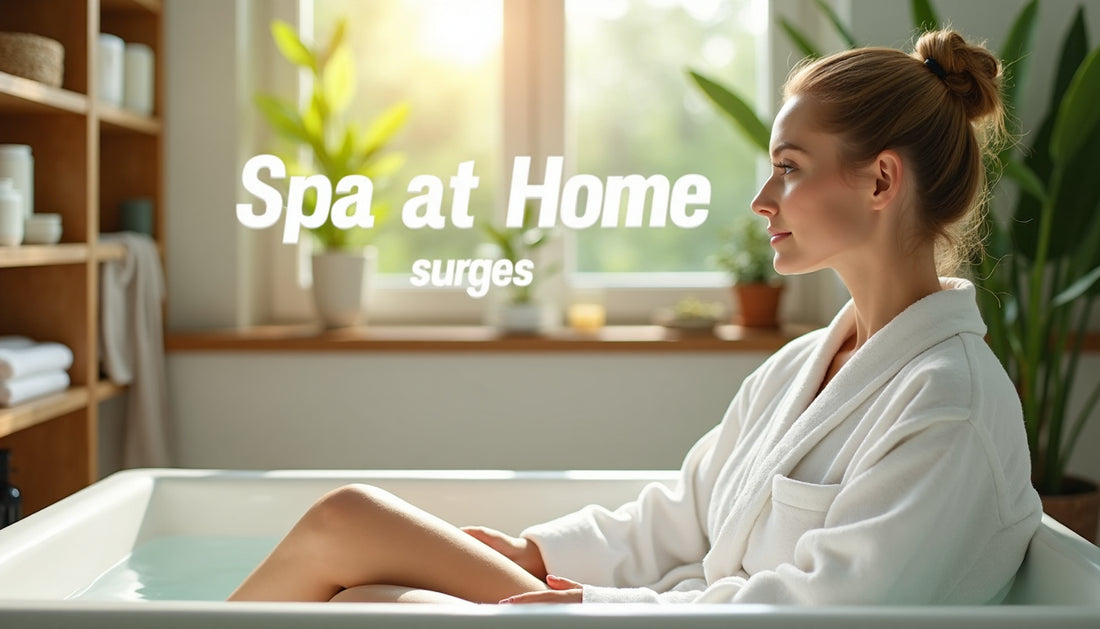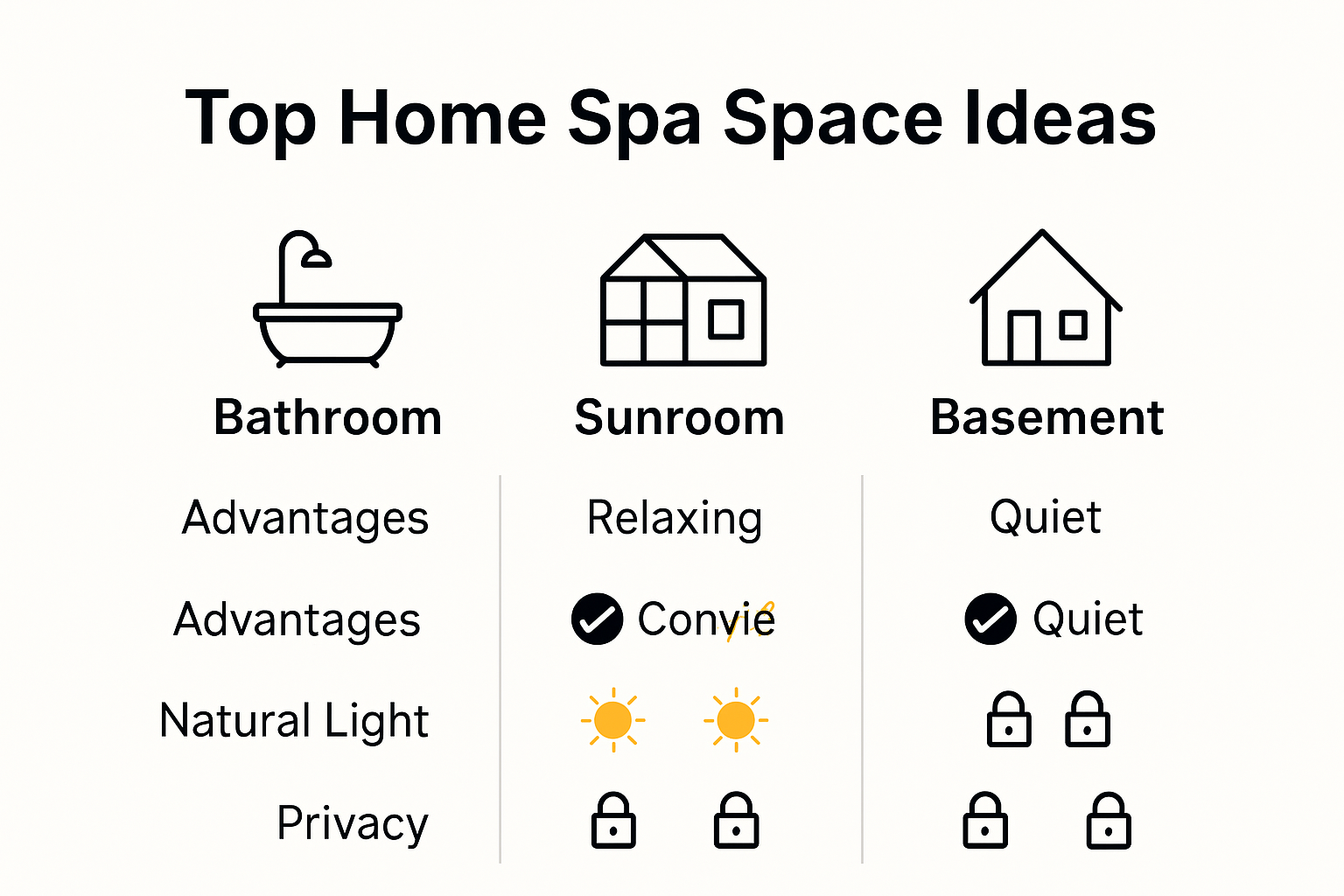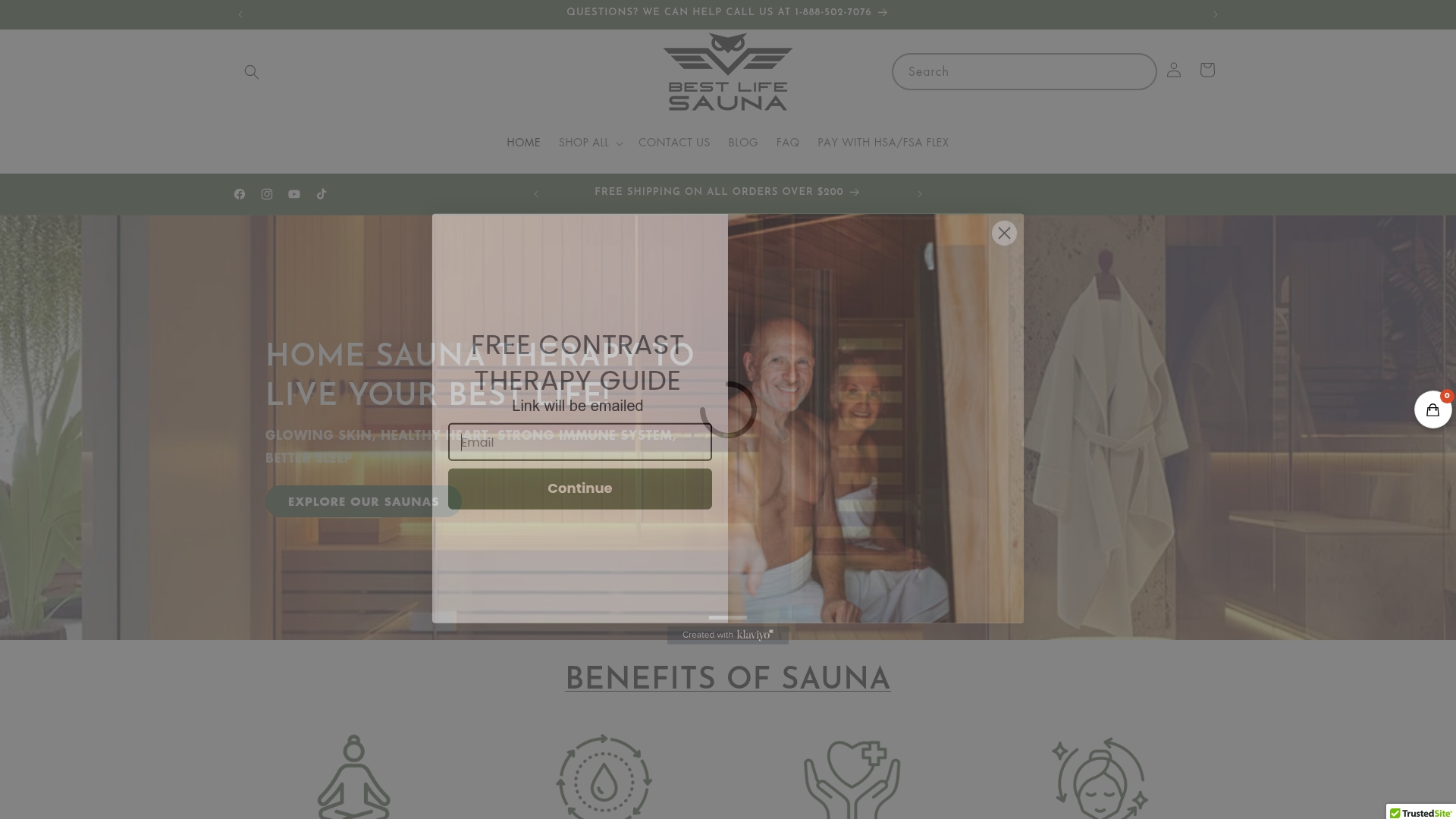
How to Create a Spa at Home: Expert Tips for Wellness 2025

Turning your living room or bathroom into a spa might sound like a splurge, but the results speak for themselves. Natural light in your spa space can actually improve mood by up to 20 percent, according to recent studies. Most people think you need luxury equipment or a huge renovation to pull this off. Turns out, even a quiet corner or a few thoughtful tools can change everything and deliver real wellness right at home.
Table of Contents
- Choosing The Right Space For Your Home Spa
- Essential Tools And Products For A Spa Experience
- Building A Relaxing Atmosphere Step By Step
- Personalizing Your Home Spa For Wellness Goals
Quick Summary
| Takeaway | Explanation |
|---|---|
| Choosing the Right Space | Identify a quiet, naturally lit area in your home that can accommodate spa elements, such as a bathroom, spare bedroom, or outdoor nook, to enhance relaxation. |
| Essential Tools for a Spa Experience | Invest in aromatherapy diffusers, massage tools, and skincare hydration essentials to create a multisensory wellness journey at home. |
| Creating a Relaxing Atmosphere | Engage your senses by decluttering the space, incorporating natural elements like plants, and using soft lighting and calming colors to promote tranquility. |
| Personalizing Your Home Spa | Establish S.M.A.R.T. wellness goals and design your space to support these objectives, ensuring it becomes a tailored sanctuary for mental and emotional well-being. |
| Utilizing Adaptive Wellness Technology | Integrate modern technological tools, such as biometric trackers and guided meditation apps, to enhance your personalized wellness experience in your home spa. |
Choosing the Right Space for Your Home Spa
Creating a home spa starts with selecting the perfect location. Your chosen space will significantly impact the overall wellness experience and relaxation potential. The right environment can transform an ordinary room into a sanctuary of tranquility and rejuvenation.
Assessing Your Home’s Potential Spa Spaces
Not every room is created equal when it comes to spa potential. Research from architectural wellness experts suggests that incorporating natural elements like wood and stone can dramatically enhance the calming atmosphere of your home spa. Look for spaces with unique characteristics that support relaxation.
Consider rooms with the following attributes:
- Natural Light: Studies show that exposure to daylight can improve mood by up to 20%. Rooms with large windows or skylights provide an instant mood-boosting advantage.
- Quiet Location: Choose an area away from high-traffic zones in your home to minimize disruptions.
- Adequate Space: Ensure the room can accommodate your desired spa elements comfortably.
Bathrooms often emerge as the most natural choice for a home spa, but don’t limit yourself. Spare bedrooms, sunrooms, or even a dedicated corner of a master bedroom can be transformed into a wellness retreat.

Creating an Optimal Spa Environment
Ventilation plays a crucial role in your home spa’s success. Experts recommend maintaining proper air circulation to prevent moisture buildup and ensure a healthy, comfortable space. This is particularly important if you’re planning to incorporate elements like steam treatments or humidity-sensitive equipment.
Consider the following environmental factors:
- Temperature control capabilities
- Moisture resistance of surfaces
- Proximity to water sources
- Electrical outlets for spa equipment
- Storage options for towels and wellness supplies
The ideal spa space should feel like a personal sanctuary. Look beyond just the physical requirements and consider the room’s energy and potential for transformation. Some homeowners find unexpected spaces perfect for their wellness retreat - a converted closet, a quiet basement corner, or even a well-designed outdoor nook can become a remarkable home spa.
Remember that creating a home spa is about more than just physical space. It’s about crafting an environment that speaks to your personal wellness journey. Take time to visualize how the space will support your relaxation, healing, and self-care goals. The right location can turn a simple room into a transformative wellness experience that rivals professional spa treatments.
Whether you have a sprawling master bathroom or a cozy corner to work with, the key is intentional design and a commitment to creating a space that nurtures both body and mind. Your home spa awaits - all it takes is the right space and a vision of wellness.
Essential Tools and Products for a Spa Experience
Transforming your home into a personal wellness sanctuary requires more than just a dedicated space. The right tools and products can elevate your spa experience from ordinary to extraordinary, creating a multisensory journey of relaxation and rejuvenation.
Aromatherapy and Sensory Wellness
Wellness experts suggest that aromatherapy plays a critical role in creating a spa-like atmosphere. Essential oils are not just fragrances but powerful tools for emotional and physical wellness. Lavender, known for its calming properties, can reduce stress and improve sleep quality. Eucalyptus offers respiratory benefits and creates a refreshing environment, while chamomile promotes relaxation and emotional balance.
Consider investing in high-quality tools to maximize your aromatherapy experience:
- Diffusers: Electric or ultrasonic models that disperse essential oils effectively
- Scented Candles: Natural wax candles with therapeutic-grade essential oils
- Roller Blends: Pre-mixed essential oil combinations for targeted wellness
Massage and Relaxation Tools
Professional wellness resources highlight the importance of massage tools in creating a comprehensive spa experience. These tools help release muscle tension, improve circulation, and promote overall relaxation.
Essential massage and relaxation tools include:
- Massage Oils: Organic, unrefined oils like jojoba, sweet almond, or coconut
- Foam Rollers: For muscle recovery and tension release
- Handheld Massagers: Percussion or vibration devices targeting specific muscle groups
- Gua Sha and Jade Rollers: For facial massage and lymphatic drainage
Skincare and Hydration Essentials
Skincare professionals recommend incorporating facial steamers and hydration tools to enhance your spa experience. These devices not only prepare the skin for deeper treatments but also provide a luxurious, professional-grade experience at home.
Key skincare and hydration tools to consider:
- Facial Steamers: Open pores and hydrate skin through warm steam treatments
- Facial Masks: Sheet masks, clay masks, and hydrogel masks for targeted skincare
- Hydration Mists: Mineral-rich sprays to refresh and nourish skin
- Exfoliation Tools: Gentle scrubs, konjac sponges, or electronic cleansing devices
Building a home spa toolkit is an investment in your personal wellness. Each product serves a purpose beyond mere aesthetics - they are instruments of self-care, designed to help you relax, recover, and reconnect with yourself. Start with a few high-quality essentials and gradually expand your collection as you discover what works best for your unique wellness journey.
Remember that the most important tool in your home spa is your intention. These products are catalysts for relaxation, but true wellness comes from mindful engagement and a commitment to nurturing your physical and emotional well-being.
Here is a table that summarizes the essential tools and products for a spa experience, categorizing them by their purpose:
| Category | Key Tools/Products | Main Benefits |
|---|---|---|
| Aromatherapy & Sensory | Diffuser, Scented Candles, Roller Blends | Relaxation, Stress Relief, Mood Balance |
| Massage & Relaxation | Massage Oils, Foam Roller, Handheld Massager, Gua Sha/Jade Roller | Muscle Relief, Circulation, Deep Relaxation |
| Skincare & Hydration | Facial Steamer, Facial Masks, Hydration Mists, Exfoliation Tools | Pore Cleansing, Skin Hydration, Nourishment |
Building a Relaxing Atmosphere Step by Step

Creating a truly relaxing home spa environment goes beyond physical tools and design. It involves intentionally crafting an atmosphere that engages all your senses and promotes deep relaxation and wellness.
Decluttering and Creating Spatial Harmony
Environmental wellness experts emphasize that a cluttered space directly impacts mental tranquility. Removing unnecessary items and organizing your spa area can significantly reduce stress and create a sense of calm. Start by eliminating distractions and creating a minimalist environment that allows your mind to settle.
Key decluttering strategies include:
- Minimal Decor: Choose few, meaningful decorative items
- Smart Storage: Use hidden storage solutions to maintain clean lines
- Clear Surfaces: Keep surfaces free from unnecessary objects
Natural Elements and Sensory Design
Design professionals recommend integrating natural elements to ground your space and create a connection with nature. Incorporating organic materials and natural textures can transform your home spa into a serene retreat.
Consider these natural design elements:
- Houseplants: Add greenery to improve air quality and visual calm
- Natural Textures: Use wooden accessories, stone elements, and natural fiber textiles
- Water Features: Small fountains or indoor water elements create soothing sounds
Lighting and Color Psychology
Wellness design research highlights the profound impact of lighting and color on emotional state. Soft, neutral tones and carefully curated lighting can dramatically enhance your spa’s relaxation potential.
Strategies for optimal atmosphere include:
- Color Palette: Choose soft blues, greens, and earthy neutrals
- Lighting Layers: Combine natural light with warm, dimmable artificial lighting
- Light Filtering: Use sheer curtains to create soft, diffused illumination
Building a relaxing atmosphere is a holistic process that engages multiple senses simultaneously. Each element - from visual design to sensory experience - contributes to creating a sanctuary of wellness. Your home spa should feel like a personal retreat that instantly helps you disconnect from daily stress and reconnect with yourself.
Remember that atmosphere is deeply personal. What creates relaxation for one person might feel different for another. Experiment with various elements, trust your intuition, and create a space that genuinely speaks to your sense of calm and rejuvenation. The goal is not perfection but a genuine feeling of peace and comfort.
Below is a table outlining the key steps for building a relaxing spa atmosphere and their intended results:
| Step | Description | Intended Result |
|---|---|---|
| Decluttering | Remove clutter, keep surfaces clear | Calm mind, reduced stress |
| Minimal and Smart Decor | Use minimal, functional, and hidden storage solutions | Visual peace, organized space |
| Incorporating Nature | Add plants, wood, stone, natural fibers, water | Sense of tranquility, grounding |
| Curated Lighting & Color | Soft colors, layered/dimmable lighting, light filters | Enhanced relaxation, comfort |
Personalizing Your Home Spa for Wellness Goals
A truly effective home spa transcends generic relaxation techniques and becomes a personalized wellness sanctuary tailored to your unique health objectives. The key lies in understanding your individual wellness goals and designing a space that supports your specific physical, mental, and emotional needs.
Defining Your Wellness Roadmap
Wellness experts recommend establishing S.M.A.R.T. goals as the foundation for creating a targeted home spa experience. These goals should be Specific, Measurable, Achievable, Relevant, and Time-bound. Whether you’re seeking stress reduction, improved sleep, muscle recovery, or mental clarity, your home spa can be strategically designed to support these objectives.
Consider identifying goals in key wellness domains:
- Physical Recovery: Muscle tension relief, flexibility improvement
- Mental Health: Stress management, meditation practice
- Emotional Wellness: Mood enhancement, anxiety reduction
- Holistic Health: Immune system support, overall energy restoration
Mindfulness and Intentional Design
Research from mindfulness experts highlights the importance of creating dedicated spaces for relaxation and introspection. Your home spa should be more than a physical space - it should be a purposeful environment that facilitates mental and emotional transformation.
Strategies for creating an intentional wellness space include:
- Meditation Zones: Designate a quiet corner with comfortable seating
- Visualization Tools: Use vision boards or inspirational artwork
- Sound Environment: Incorporate sound therapy elements like singing bowls or gentle music
- Ritual Development: Create consistent wellness routines that anchor your practice
Adaptive Wellness Technology and Tools
Wellness design professionals suggest integrating technology and specialized tools that support personalized wellness tracking and enhancement. Modern home spas can leverage technology to create more targeted and measurable wellness experiences.
Consider incorporating:
- Biometric Tracking Devices: Monitor heart rate, stress levels, and recovery
- Adaptive Lighting Systems: Adjust color and intensity based on time of day and wellness goals
- Smart Aromatherapy Diffusers: Programmed essential oil releases
- Guided Meditation Applications: Personalized mindfulness programs
Personalizing your home spa is an evolving journey of self-discovery. Your wellness space should be flexible, allowing for adjustments as your health goals and needs change. Approach this process with curiosity and compassion, understanding that wellness is not a destination but a continuous, dynamic exploration.
Remember that the most sophisticated equipment or beautiful design means little without your consistent intention and engagement. Your commitment to regular practice transforms a simple room into a powerful wellness sanctuary. Start with small, meaningful steps, and allow your home spa to grow and adapt alongside your personal wellness journey.
Frequently Asked Questions
How do I choose the right space for my home spa?
Identify a quiet area in your home with ample natural light, away from high-traffic zones. This could be a bathroom, spare bedroom, or even an outdoor nook for optimal relaxation.
What essential tools do I need to create a spa experience at home?
Invest in aromatherapy diffusers, massage tools, and skincare hydration essentials. Items like essential oils, handheld massagers, and facial steamers will enhance your home spa experience.
How can I create a relaxing atmosphere in my home spa?
Declutter the space to promote calmness, incorporate natural elements like plants, and use soft lighting with calming colors. These elements collectively contribute to a serene environment.
What are some personalized wellness goals for my home spa?
Define S.M.A.R.T. goals like stress reduction, improved sleep, or muscle recovery. Tailor your spa environment to support these objectives, ensuring it meets your specific wellness needs.
Elevate Your At-Home Spa With Wellness Solutions That Truly Work
Are you searching for more than just a calming corner or simple aromatherapy? The article revealed how lighting and the right tools can nurture deep relaxation, but many home spa dreams fall short without advanced wellness products that deliver real results. If you are ready to shift from small upgrades to genuine transformation, it is time to explore what expert-level home wellness looks like.

Discover the ultimate advantage of planning your wellness journey with Best Life Sauna, where you will find premium saunas, outdoor spa solutions, and wellness accessories tailored for every stage of at-home rejuvenation. Try out an infrared or traditional sauna to gain benefits such as improved stress relief, better blood circulation, and glowing skin—on your terms. Visit the Best Life Sauna main site today to unlock free shipping and see which solution could turn your ordinary space into a personalized spa sanctuary. Now is the perfect time to invest in your well-being and experience the difference for yourself.

